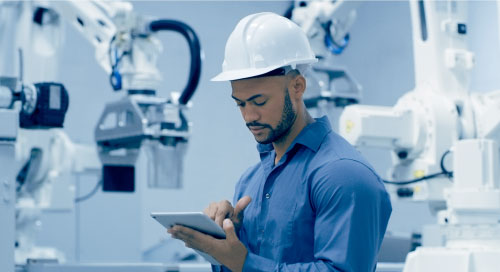Fill form to unlock content
Error - something went wrong!
Your content is just a step away. Please submit below.
Thank you!
Built-in Functional Safety Speeds Robot Development

In today’s factories and warehouses, robots are no longer fenced off from humans. The two often work side by side, with robots taking over arduous tasks like transporting heavy objects—or tedious ones, like spray-painting or palletizing goods.
These collaborative robots, or “cobots,” increase efficiency and reduce the risk that workers will develop muscle strain or injuries. But ensuring that they interact with people safely is not an easy accomplishment. Robot developers can spend years building, testing, and retesting safety features, which must meet rigorous certification requirements. That delays them from releasing models with the latest and greatest capabilities and leads to longer time to revenue.
But now there’s a way for machine builders to bring their robots to market sooner. Building them with pre-certified processors, control boards, and electronics can spare them months or years of extra work.
Faster Robot Development
Critical systems like robots that work in cooperation with humans must include robust functional safety (FuSa) controls. FuSa is an international standard methodology for automatically detecting and mitigating electronic system malfunctions in critical systems—in this case, malfunctions that could harm people. For example, if a robot’s FuSa system indicates that it is veering off-course or traveling too fast, it will send a signal to stop all moving parts.
To gain approval for their cobots, developers must build in FuSa controls for every action they perform that could affect people. Their traveling velocity, the amount of force they use to grasp an object from a human hand, the torque they exert in rotation—these and many other variables must meet exacting ISO standards, and sometimes country-specific ones as well. Both hardware and software related to functional safety must obtain certification.
For the hardware, each of the thousands of electronic components in a robot’s embedded computer must obtain certification from a qualified institute. If a developer builds robots from scratch, the process can take several years. “That’s why we created a safety controller that uses pre-certified CPUs,” says Weihan Wang, Manager of Robot Products at NexCOBOT, a NEXCOM International Co., Ltd. company and developer of intelligent robot control and motion control solutions.
The NexCOBOT SCB 100 safety control board contains pre-certified Intel Atom® x6000 series processors, saving time for both NexCOBOT and its developer customers. “We don’t need to prove the CPU is safe because Intel has already done that,” Wang says. In addition, the entire SCB 100 board itself is FuSa certified.
Along with its silicon and software, Intel provides technical documentation such as safety manuals, safety analysis, and user guides, which also makes the certification process faster and simpler.
With all the hardware pre-certified, robot builders using the SCB 100 board can develop their applications immediately, instead of waiting for hardware approval first. They can further speed software development using built-in Intel software libraries, which enable them to easily import existing applications and develop customized safety protocols for capabilities to fit specific customer needs.
As #robots learn to do more, their interactions with humans start to look less like command-and-control and more like teamwork. @NEXCOMUSA via @insightdottech
Ensuring FuSa for Critical Systems
The SCB 100 control board safeguards robot actions with Intel® Safety Island (Intel® SI), which is integrated into the Intel processor. Safety Island supports functional safety, orchestrates Intel-on-chip diagnostics, reports errors, and monitors customer-safety applications. When a robot is in operation, Safety Island constantly checks its calculations for direction, speed, force, and other factors in real time to make sure it operates correctly. “There are over a hundred different issues that could cause a problem, including a power deviation or a memory failure,” Wang says.
If a safety error occurs, the system brings the robot to an immediate halt and sends feedback about the problem to the operator’s systems integrator.
The processors have the performance power to run multiple AI and computer vision workloads—combining non-safety motion control with safety applications. This allows developers to build in more functionality while saving space and money. The result is a lighter, more compact robot that is easier for customers to install and deploy in tight spaces.
The Future: Robots as Partners
As robots learn to do more, their interactions with humans start to look less like command-and-control and more like teamwork. For example, instead of using a handheld safety pendant for robot training, a developer may directly hand the robot an unfinished part, then guide it to a CNC machine to deposit for contouring.
“In the future, there will be more and more collaboration between humans and robots,” Wang says. In the next five to 10 years, he expects to see “humanoid” robots—with artificial arms and legs—working alongside people in factories, shops, and warehouses.
The more duties robots assume as they work with humans, the more built-in safety they will need. Regulators who once required developers to provide two or three FuSa controls are already asking for more than 30, Wang says. As more-capable robots march onto factory and warehouse floors, the pressure to release models with advanced features will increase. Using a pre-certified safety control board will help developers bring highly complex models to market faster.
Using high-performance chips will help, too, Wang says, adding, “High-end computing performance allows robots to execute lots of safety functions, and they can do it without using multiple CPUs.”
This article was edited by Georganne Benesch, Editorial Director for insight.tech.